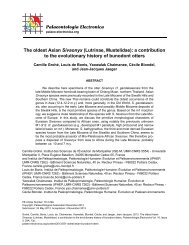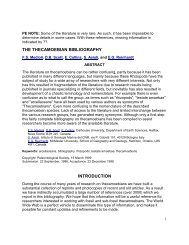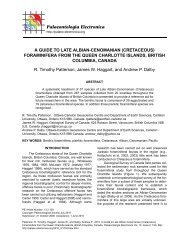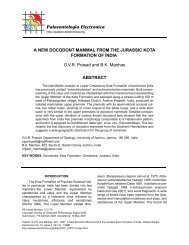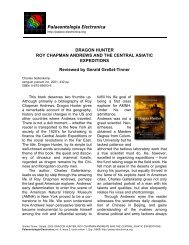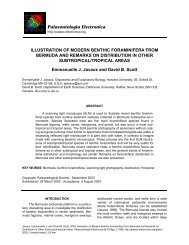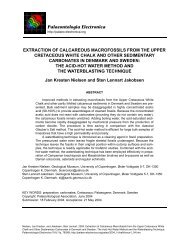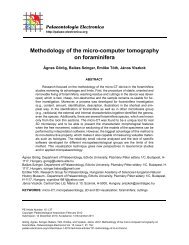Appendicular skeleton and dermal armour of the Late Cretaceous ...
Appendicular skeleton and dermal armour of the Late Cretaceous ...
Appendicular skeleton and dermal armour of the Late Cretaceous ...
You also want an ePaper? Increase the reach of your titles
YUMPU automatically turns print PDFs into web optimized ePapers that Google loves.
PALAEO-ELECTRONICA.ORG<br />
FIGURE 6. Left metatarsal III (MCNA 14474) <strong>of</strong> <strong>the</strong> titanosaurian sauropod Lirainosaurus astibiae from <strong>the</strong> <strong>Late</strong> <strong>Cretaceous</strong><br />
<strong>of</strong> Laño (nor<strong>the</strong>rn Spain) in 1. plantar, 2. lateral, 3. dorsal, 4. medial, 5. proximal <strong>and</strong> 6. distal views (dorsal<br />
towards top).<br />
being more perpendicular to <strong>the</strong> ventral surface<br />
than <strong>the</strong> o<strong>the</strong>r. Although most <strong>of</strong> <strong>the</strong> osteoderm<br />
bodies are missing, <strong>the</strong>y could have belonged to<br />
<strong>the</strong> ellipsoid morphotype described by D’Emic et al.<br />
(2009), being part <strong>of</strong> <strong>the</strong> “root” first described in <strong>the</strong><br />
osteoderms <strong>of</strong> Ampelosaurus atacis (Le Loeuff et<br />
al., 1994; Le Loeuff, 1995, 2005).<br />
COMPARISONS<br />
Pectoral Girdle<br />
Elements from <strong>the</strong> scapular girdle are known<br />
for several European titanosaurs: Lirainosaurus<br />
astibiae, Ampelosaurus atacis, Atsinganosaurus<br />
velauciensis <strong>and</strong> Magyarosaurus dacus (but <strong>the</strong><br />
preservation <strong>of</strong> <strong>the</strong> remains <strong>of</strong> <strong>the</strong> latter taxon complicates<br />
its comparison with <strong>the</strong> o<strong>the</strong>r taxa). As<br />
observed in <strong>the</strong> material from <strong>the</strong> type locality <strong>of</strong><br />
Laño, <strong>the</strong> scapula <strong>of</strong> L. cf. astibiae is laterally convex<br />
<strong>and</strong> has a ventral ridge <strong>and</strong> a dorsal prominence<br />
on <strong>the</strong> medial surface. A. atacis also has a<br />
ventral crest on its medial surface, but not <strong>the</strong> dorsal<br />
one (it shows a medio-dorsal protuberance).<br />
However, <strong>the</strong> ventral crest <strong>of</strong> Ampelosaurus is not<br />
as prominent as <strong>the</strong> one present in <strong>the</strong> scapula <strong>of</strong><br />
Lirainosaurus. Opisthocoelicaudia presents a ventral<br />
rugosity in <strong>the</strong> medial surface <strong>of</strong> <strong>the</strong> scapular<br />
blade for <strong>the</strong> insertion <strong>of</strong> <strong>the</strong> serratus superficialis<br />
muscle (Borsuk-Bialynicka, 1977). The ventral<br />
ridges shown by <strong>the</strong> scapulae <strong>of</strong> Lirainosaurus <strong>and</strong><br />
Ampelosaurus probably have <strong>the</strong> same function as<br />
that <strong>of</strong> Opisthocoelicaudia skarzynskii, although in<br />
<strong>the</strong>se European titanosaurs <strong>the</strong>y are much more<br />
developed. In Atsinganosaurus <strong>and</strong> Magyarosaurus<br />
(NHMUK R. 3816) <strong>the</strong>re are no medial ridges.<br />
Saltasaurus loricatus <strong>and</strong> Neuquensaurus australis<br />
do present a dorsal prominence in <strong>the</strong> medial surface<br />
<strong>of</strong> <strong>the</strong> scapular blade similar to that <strong>of</strong> Lirainosaurus<br />
– though more developed, <strong>the</strong>y are more<br />
like a ridge – but <strong>the</strong>se Argentinean titanosaurs do<br />
not show a medial ventral ridge (Powell, 1992).<br />
Therefore, <strong>the</strong> combination <strong>of</strong> a dorsal prominence<br />
<strong>and</strong> a ventral ridge on <strong>the</strong> medial surface <strong>of</strong> <strong>the</strong><br />
scapular blade is only known in <strong>the</strong> scapulae <strong>of</strong><br />
Lirainosaurus.<br />
11



